Feel Better In Your Body!
Structural Integration Bodywork, Neuromuscular Therapy and Massage Therapy by Thomas Jody Howard, LMBT.
Jody is Nationally Certified and licensed in North Carolina to practice Massage and Bodywork Therapy, and is a Board Certified Structural Integratorcm (please be sure to scroll down the page for an overview of this unique and powerful approach). Advanced training and an experienced touch ensure that you get the work that best suits your goals, from relaxation and stress reduction massage to relief from pain and functional limitations. Jody has enjoyed helping clients return to running and golfing, and others find lasting relief while dealing with chronic conditions.
Neuromuscular Therapy (NMT) is a thorough program of recovery from acute and chronic pain syndromes which utilizes specific massage and trigger point therapy, flexibility stretching, and home care to eliminate the causes of most neuromuscular pain patterns. If you are experiencing chronic headaches, neck or back pain, sciatica symptoms, wrist or carpal tunnel problems, epicondylits (tennis or golfer's elbow), plantar fasciitis, tmj dysfunction, pain or limitation in the shoulders, hips, knees (to name a few), this work can offer a significant improvement in your quality of life. Jody is certified through the NMT Center in St Petersberg, FL. To learn more, click here.
Structural Integration is an approach to bodywork which seeks to enhance vitality and well-being by restoring optimal alignment and evenness of tone throughout a person’s physical structure. It is distinguished from massage and other bodywork in that it addresses the fascial network as a whole rather than focusing on individual muscles or problem areas. This is done in a strategic way, based on the patterns of each individual, over a series of sessions. Each session addresses a specific territory, preparing the body for the work to come in the next session. The idea is to "open up the body without opening a can of worms".
Structural Integration is a powerful experience on its own, and it also is a wonderful complement to Yoga, Pilates, Acupuncture, Chiropractic, Physical Therapy and Psychotherapy.
About Structural Integration Bodywork
"Structural Integration is dedicated to the exploration of the human body, based upon the understanding that it carries transformational potential for total being."
—Ida P. Rolf, Ph.D.
Structural Integration was developed by Dr. Ida Rolf. Quoting the back cover of her book on Structural Integration,
"Ida P Rolf (1896-1979) received her Ph.D. in biochemistry from Columbia University in 1920. She subsequently worked at the Rockefeller Institute in the departments of chemotherapy and organic chemistry. She came upon the idea of Rolfing, or Structural Integration, during her search to solutions to family health problems. Finding available methods inadequate, she investigated the effects of structure on function...."
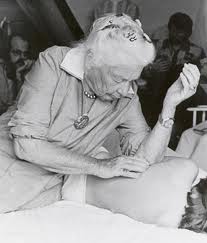
Her success at home led to others seeking her help. She based her approach largely on her experience with Hatha Yoga, later drawing from Osteopathy and other movement and manual therapy modalities.
It was later in her life that she developed a coherent approach that she could teach to others. Structural Integration is what she called her approach, but it quickly became known as Rolfing, and it's practitioners as Rolfers.
Since then, several of her original students have started schools based on their own developments in Structural Integration.
One of these was Thomas Myers, who also studied with movement therapist Moshe Feldenkrais and other luminaries.
About Anatomy Trains SI
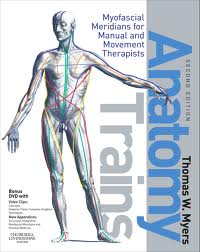 While he was teaching anatomy at the Rolf Institute, he began speaking of "myofascial meridians" as a way to teach students how strain can be transmitted along continuous lines of pull formed by a series of muscles linked by the fascial sheets that wrap them.
While he was teaching anatomy at the Rolf Institute, he began speaking of "myofascial meridians" as a way to teach students how strain can be transmitted along continuous lines of pull formed by a series of muscles linked by the fascial sheets that wrap them.
His ideas have become popular and influential not only among Structural Integrators but also among massage therapists, yoga teachers, personal trainers, dancers, etc.
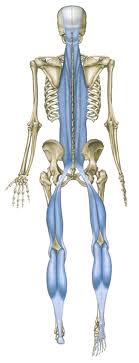 One example of a myofascial meridian is along the back of the body- Starting at the feet, up the calves, to the hamstrings, to the sacrotuberous ligament, to the erectors of the back, on up to the scalp. Each muscle along the line links directly with the next so that strain in one muscle will create a pull on the whole line.
One example of a myofascial meridian is along the back of the body- Starting at the feet, up the calves, to the hamstrings, to the sacrotuberous ligament, to the erectors of the back, on up to the scalp. Each muscle along the line links directly with the next so that strain in one muscle will create a pull on the whole line.
So while the Rolf method of Structural Integration is based on a ten-session protocol, each session covering specific territory of the body, Myers started diverging somewhat from Rolf’s “recipe” by organizing each session around a particular myofascial meridian. This led to the addition of two more sessions, making twelve the standard number of sessions in a series.
This particular approach to Structural Integration – the one I practice - is called KMI, short for Kinesis Myofascial Integration (since renamed ATSI, Anatomy Trains Structural Integration).
RELATIONSHIP
Before beginning any work with a person, in addition to asking about history, goals and present challenges, we look at how the segments of the body relate.
As an example, if someone has a problem like pain or restriction in their shoulder, we would look at how the shoulder girdle rests on the ribcage, and then on down:
What is the ribcage/torso responding to from below – is there a tilt or a rotation at the pelvis? If so, does that correspond to a compromise at the knee or ankle or arch of the foot?
Working where the pain or restriction is often does not bring lasting relief as it may not address the underlying structural factors.

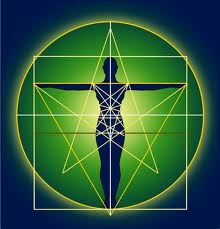 Also, Better Alignment allows for Better Flow – of blood, nerve signals, lymph, energy, movement….
Also, Better Alignment allows for Better Flow – of blood, nerve signals, lymph, energy, movement….
Where we find asymmetry and misalignment, we look for how much of it is due to soft tissue patterns that we can affect. Where can we encourage better relationship between flexors and extensors? Between front and back, left to right, inner to outer…... The idea is to find an ideal balance between stability and mobility. What is stuck that might be able to move more freely? Which areas may need to be tonified to promote stability?
INTEGRATION
In addition to the kinds of relationships I already mentioned- front/back, side to side, pelvis to femurs, and so on, we also explore other connections, such as how postural patterns and habits relate to emotion and to attitude.
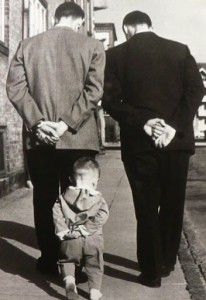 We consider how the way we hold ourselves in sitting, standing, and in movement have been influenced by our family and our culture, and how it affects the way we feel physically and emotionally. Experiments in movement, early and later in life, become habits, which become posture. Given time, posture becomes structure.
We consider how the way we hold ourselves in sitting, standing, and in movement have been influenced by our family and our culture, and how it affects the way we feel physically and emotionally. Experiments in movement, early and later in life, become habits, which become posture. Given time, posture becomes structure.
Even though the discussion so far has been all about the physical aspects, the integration of mind, body and spirit is also an important goal of this work. Our posture and our structure are intimately related to our emotional and mental states. A change in one produces a change in the other. Drugs and therapy will have limited long-term effect without changes to posture and structure.
"For every thought supported by feeling, there is a muscle change. Primary muscle patterns being the biological heritage of man, man's whole body records his emotional thinking." -Mabel Ellsworth Todd
Click here for more great quotes related to the body-mind.
This brings us back to Structural Integration's roots in Ida Rolf’s training in yoga. Growing up when and where she did, Ida Rolf didn't imagine that yoga would ever go over in the West. Structural Integration seems to have been born from her attempts to find a way for Americans to have the yogic experience- integration of the physical and psycho-spiritual.
In its original context, hatha yoga is practiced not just for physical flexibility, strength and balance (great benefits, but not the main point), but as a way of developing awareness:
Awareness of the body-mind connection and the flow of the divine energy through this body-mind...
The term yoga means union; union with the Divine is the implication. Likewise, the term integration implies a higher level of organization, alignment, flow and awareness;
Less strain, better function, and living more fully...
While experiencing Structural Integration doesn’t guarantee a spiritual epiphany or psychological breakthrough, when it is approached with a spirit of open exploration and heightened awareness, there is real potential for personal growth and transformation.
Doesn’t it sound like fun? I trained in this approach because I have found it to be powerful and exciting stuff. I hope it sounds like something you would like to explore.
Just off Hwy 1/64 in Apex, NC , the office is convenient to Raleigh, Cary, Holly Springs, Fuquay-Varina, and Durham
